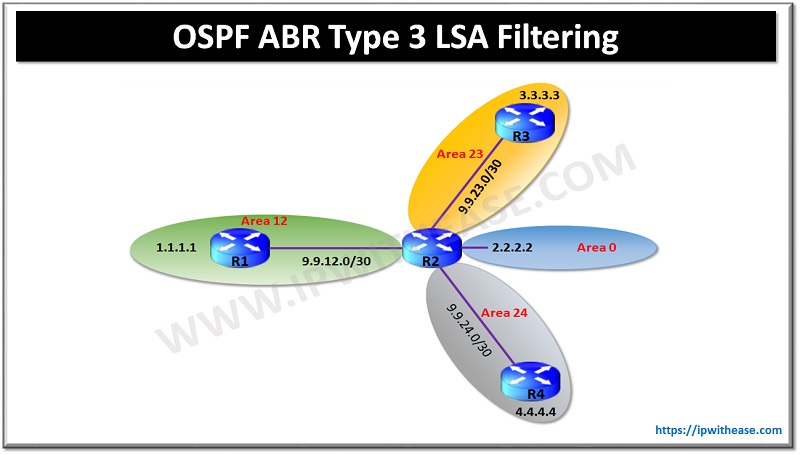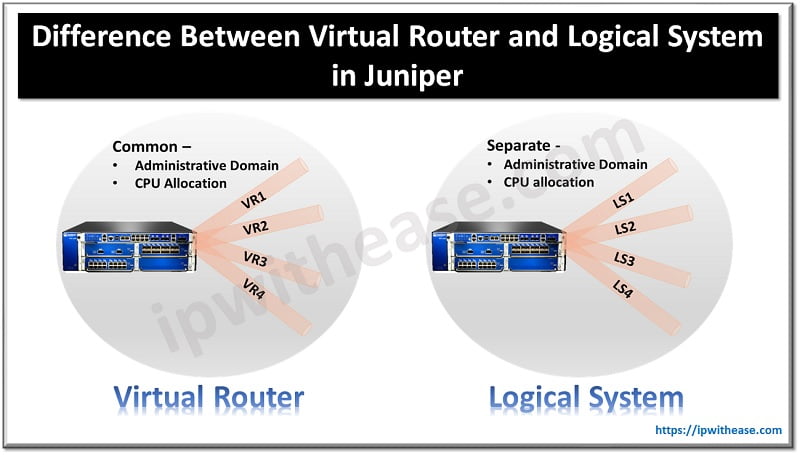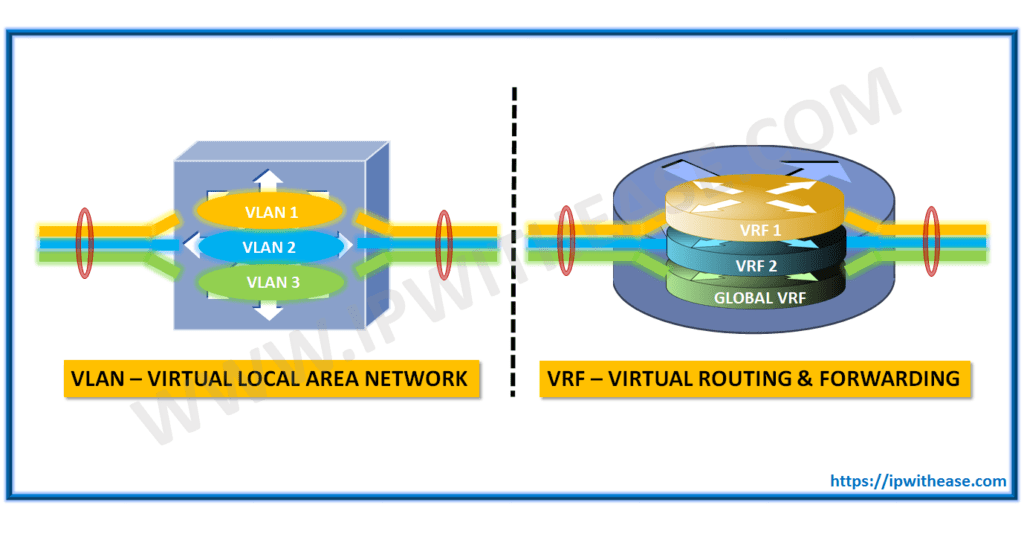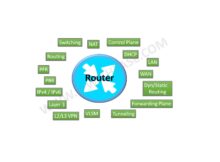OPSF LSA Type 3 is used for exchanging inter-area routes between different OSPF areas. We may use filter on ABR either inbound or outbound to filter to control the sharing of the LSA3 between different areas.
OSPF ABR Type 3 LSA Filtering: Scenario
We will use the topology below to demonstrate how we can filter the inter-area Type 3 LSA on ABR –

In the topology above R2 is acting as the ABR and has 3 OSPF adjacencies along with router R1, R3 and R4. We have created loopbacks on each router and all are advertised in OSPF domain.
Configuration of OSPF ABR Type 3 LSA Filtering
R1:
ip address 1.1.1.1 255.255.255.255
!
interface FastEthernet0/0
ip address 9.9.12.1 255.255.255.0
!
router ospf 1
network 1.1.1.1 0.0.0.0 area 12
network 9.9.12.0 0.0.0.255 area 12
R2:
ip address 2.2.2.2 255.255.255.255
!
interface FastEthernet0/0
ip address 9.9.12.2 255.255.255.0
!
interface FastEthernet1/0
ip address 9.9.23.2 255.255.255.0
!
interface FastEthernet1/1
ip address 9.9.24.2 255.255.255.0
!
router ospf 2
network 2.2.2.2 0.0.0.0 area 0
network 9.9.12.0 0.0.0.255 area 12
network 9.9.23.0 0.0.0.255 area 23
network 9.9.24.0 0.0.0.255 area 24
R3
ip address 3.3.3.3 255.255.255.255
!
interface FastEthernet0/0
ip address 9.9.23.3 255.255.255.0
!
router ospf 23
network 3.3.3.3 0.0.0.0 area 23
network 9.9.23.0 0.0.0.255 area 23
R4
ip address 4.4.4.4 255.255.255.255
!
interface FastEthernet0/0
ip address 9.9.24.4 255.255.255.0
!
router ospf 24
network 4.4.4.4 0.0.0.0 area 24
network 9.9.24.0 0.0.0.255 area 24
Currently we see the OSPF neighborship is up on R2 with all three peers.
R2#sh ip ospf nei
1.1.1.1 1 FULL/DR 00:00:36 9.9.12.1 FastEthernet0/0
9.9.23.3 1 FULL/BDR 00:00:39 9.9.23.3 FastEthernet1/0
4.4.4.4 1 FULL/DR 00:00:34 9.9.24.4 FastEthernet1/1
Currently we see all routes from one area are flowing into the other areas as below:
R1#sh ip route ospf
D – EIGRP, EX – EIGRP external, O – OSPF, IA – OSPF inter area
N1 – OSPF NSSA external type 1, N2 – OSPF NSSA external type 2
E1 – OSPF external type 1, E2 – OSPF external type 2
i – IS-IS, su – IS-IS summary, L1 – IS-IS level-1, L2 – IS-IS level-2
ia – IS-IS inter area, * – candidate default, U – per-user static route
o – ODR, P – periodic downloaded static route, H – NHRP, l – LISP
+ – replicated route, % – next hop override
Gateway of last resort is not set
2.0.0.0/32 is subnetted, 1 subnets
O IA 2.2.2.2 [110/2] via 9.9.12.2, 00:00:20, FastEthernet0/0
3.0.0.0/32 is subnetted, 1 subnets
O IA 3.3.3.3 [110/3] via 9.9.12.2, 00:00:25, FastEthernet0/0
4.0.0.0/32 is subnetted, 1 subnets
O IA 4.4.4.4 [110/3] via 9.9.12.2, 00:00:25, FastEthernet0/0
9.0.0.0/8 is variably subnetted, 4 subnets, 2 masks
O IA 9.9.23.0/24 [110/2] via 9.9.12.2, 00:00:25, FastEthernet0/0
O IA 9.9.24.0/24 [110/2] via 9.9.12.2, 00:00:25, FastEthernet0/0
As seen in the output above we are getting all routes 2.2.2.2, 3.3.3.3, & 4.4.4.4 on the router R1 as inter-area routes.
Now let us configure filtering on R2 so we don’t advertise 3.3.3.3 to R1.
R2
ip prefix-list To_Area12 seq 10 permit 0.0.0.0/0 le 32
R2(config-router)#area 23 filter-list prefix To_Area12 in
Verification
R2#sh ip ospf 2 | be 12
Number of interfaces in this area is 1
Area has no authentication
SPF algorithm last executed 00:01:43.880 ago
SPF algorithm executed 9 times
Area ranges are
Area-filter To_Area12 in
Number of LSA 7. Checksum Sum 0x04799D
Number of opaque link LSA 0. Checksum Sum 0x000000
Number of DCbitless LSA 0
Number of indication LSA 0
Number of DoNotAge LSA 0
Flood list length 0
Now finally let’s check on R1 and we shouldn’t be getting 3.3.3.3 any longer on R1.
R1#sh ip route ospf
D – EIGRP, EX – EIGRP external, O – OSPF, IA – OSPF inter area
N1 – OSPF NSSA external type 1, N2 – OSPF NSSA external type 2
E1 – OSPF external type 1, E2 – OSPF external type 2
i – IS-IS, su – IS-IS summary, L1 – IS-IS level-1, L2 – IS-IS level-2
ia – IS-IS inter area, * – candidate default, U – per-user static route
o – ODR, P – periodic downloaded static route, H – NHRP, l – LISP
+ – replicated route, % – next hop override
Gateway of last resort is not set
2.0.0.0/32 is subnetted, 1 subnets
O IA 2.2.2.2 [110/2] via 9.9.12.2, 00:06:55, FastEthernet0/0
4.0.0.0/32 is subnetted, 1 subnets
O IA 4.4.4.4 [110/3] via 9.9.12.2, 00:06:55, FastEthernet0/0
9.0.0.0/8 is variably subnetted, 4 subnets, 2 masks
O IA 9.9.23.0/24 [110/2] via 9.9.12.2, 00:06:55, FastEthernet0/0
O IA 9.9.24.0/24 [110/2] via 9.9.12.2, 00:06:55, FastEthernet0/0
The above configuration and verification shows how “Area Filter-List” may be used to perform LSA 3 Filtering.
Continue Reading:
OSPF LSA Types: The Ultimate Guide
Configuring OSPF Multi-Area Adjacency : Example Scenario
ABOUT THE AUTHOR

You can learn more about her on her linkedin profile – Rashmi Bhardwaj



